This delicious Walnut Crusted Salmon is the best oven baked salmon recipe! Topped with a creamy layer of Dijon mustard, dill, lemon and a crunchy walnut crust, it’s packed full of healthy omegas-3s and flavor! It’s so good, you’ll swear you’re eating at a restaurant and it takes less than 30 minutes to prepare! {Gluten-free, dairy-free, & paleo}
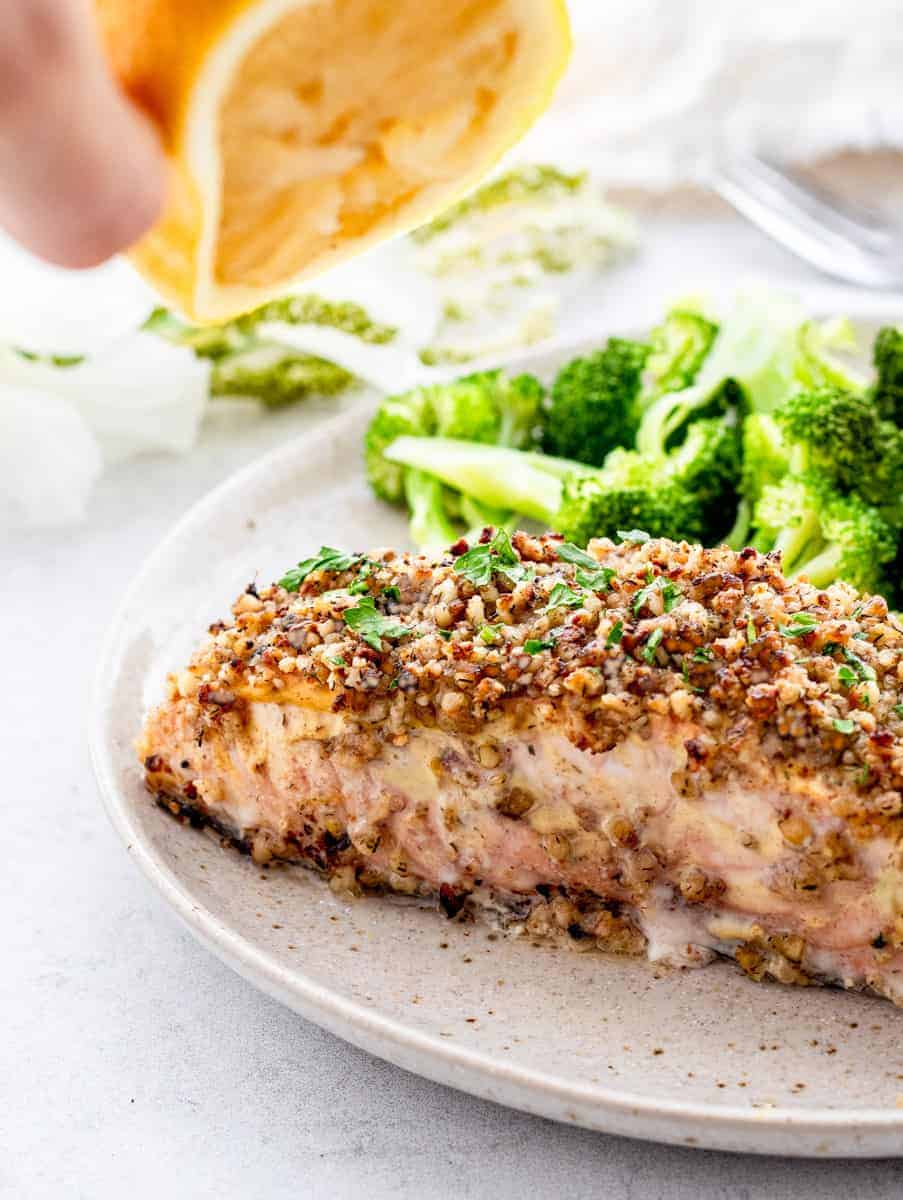
Table of Contents
Walnut Crusted Salmon Recipe
I’ve always loved the combination of Dijon mustard, salmon and dill, but the crunch of the chopped walnuts just takes it up to a whole new level.
These walnut crusted salmon fillets are so easy to make and are ready to serve in less than 30 minutes, making it a great option for an easy and healthy weeknight meal.
The current recommendation is to aim to get about two servings of fatty fish per week, so this is a tasty way to keep on track!
Why We Love this Salmon Walnut Recipe
- Healthy: If you’re looking for good brain and heart food, this is your dish. Talk about a mega dose of omega 3 fatty acids with the salmon and those crunchy walnuts! This recipe is also a great source of protein with 36 grams of protein per serving.
- Quick: It takes no more than 10 minutes to prep this sheet pan dinner and only around 10 to 15 minutes for this fish to bake in the oven, depending on the thickness of your fillets. Perfect for a busy weeknight!
- Simple ingredients: There’s nothing fancy about this recipe. You only need a handful of ingredients, but the end result is totally mouthwatering!
Ingredient Notes
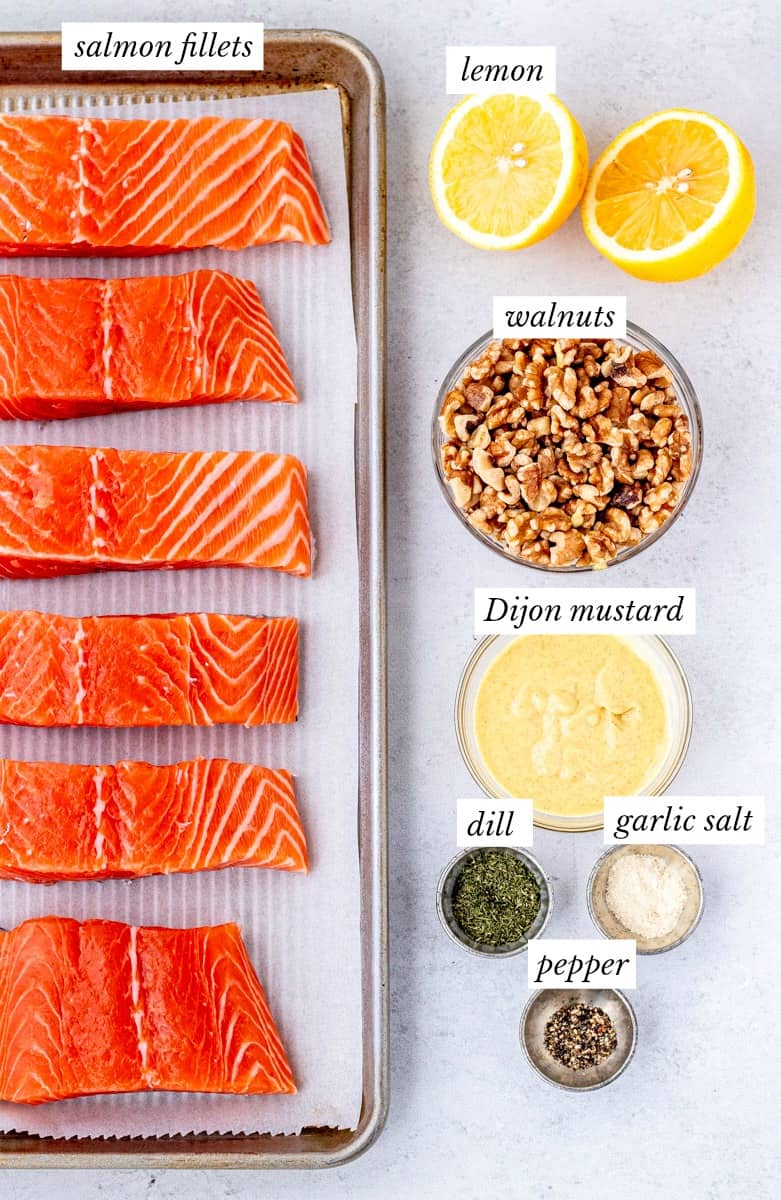
- Salmon: Salmon is an excellent source of omega 3s and is high in protein. Ideally, it’s best to look for wild Alaskan salmon if you can find it. I like to use fresh salmon fillets, but frozen can be used as well.
- Walnuts: Walnuts contribute more polyunsaturated fat and add a great crunchy texture to the flaky salmon. I used raw unsalted walnut pieces, but you can use whole walnuts as well since they will be broken down in the food processor.
- Mustard: I used Dijon mustard for this recipe for a really nice tang. It compliments the salmon and dill flavors so nicely. If you prefer a milder mustard flavor, you can use whole grain mustard.
- Seasonings: Lemon zest and juice, dill, garlic salt and pepper add amazing flavor to the walnut crust!
How to Make Salmon with Walnuts – Step-by-Step Instructions
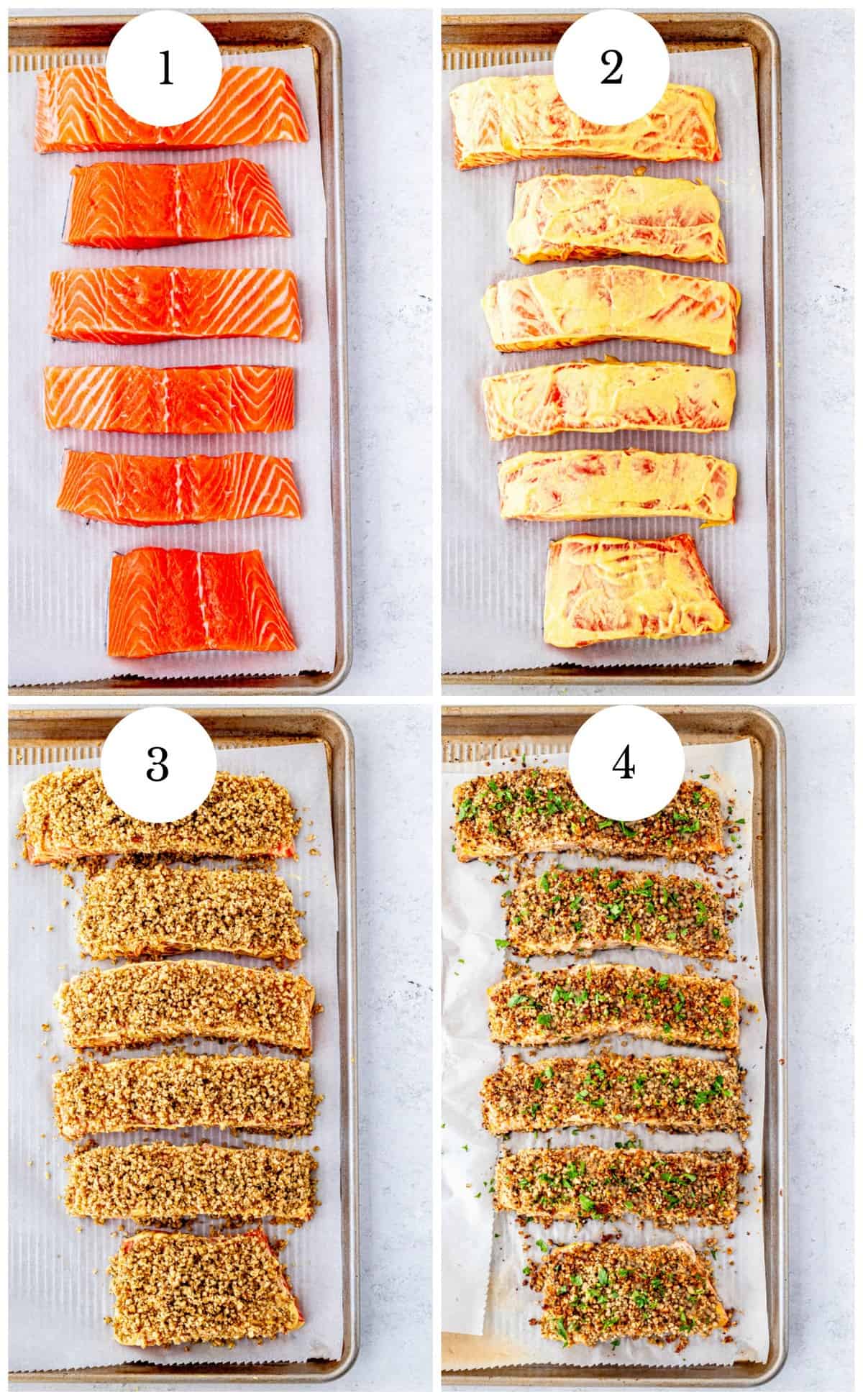
- Preheat oven to 400°F. Line a baking sheet with parchment paper.
- Place walnuts in food processor; coarsely chop. Add lemon rind, olive oil, dill, garlic salt, and pepper; pulse until crumbly. Mixture should be crumbly and stick together slightly. Set aside.
- Place salmon fillets skin side down on the parchment paper lined baking sheets. Spread Dijon mustard evenly over the top and sides of the fillets.
- Evenly distribute walnut mixture on top of the salmon fillets; gently pressing the mixture into the surface of the fish. You can also put some of the mixture on the sides if you have extra.
- Bake for 12-16 minutes, or until salmon flakes with a fork. You may need to increase the cooking time depending on the thickness of the fish fillet. You may also wish to broil for the last two minutes of cooking to get the edges brown and crispy. Just before serving, sprinkle each salmon fillet with lemon juice.
Keep scrolling to the recipe card below for the full printable recipe!
Recipe Tips:
- You can purchase salmon with or without the skin on. For fillets with skin, if desired, use a sharp fillet knife to remove the skin from the raw salmon. You can also remove the skin after baking. If any scales are on the skin, scrape them away before baking fish.
- If your salmon comes in one large piece, cut it into individual fillets before topping it with the Dijon and walnut mixture for easier baking and better presentation.
- I like to spread the Dijon mustard all over the salmon fillets, including the tops and sides to infuse flavor into every bite.
- You may need to adjust the cooking time depending on the thickness of the fish fillet. The salmon should be pink and flake easily with a fork. See the FAQs below for a general guide on cooking times for salmon.
- To get the edges brown and crispy, you may wish to broil the fish for the last two minutes of cooking. Just be sure that you don’t place the baking sheet on the top shelf of the oven too close to the broiler or the walnuts may burn.
- Don’t overcook the salmon or it will be dry. Always check your fish at the minimum baking time to ensure your baked salmon doesn’t get overcooked.
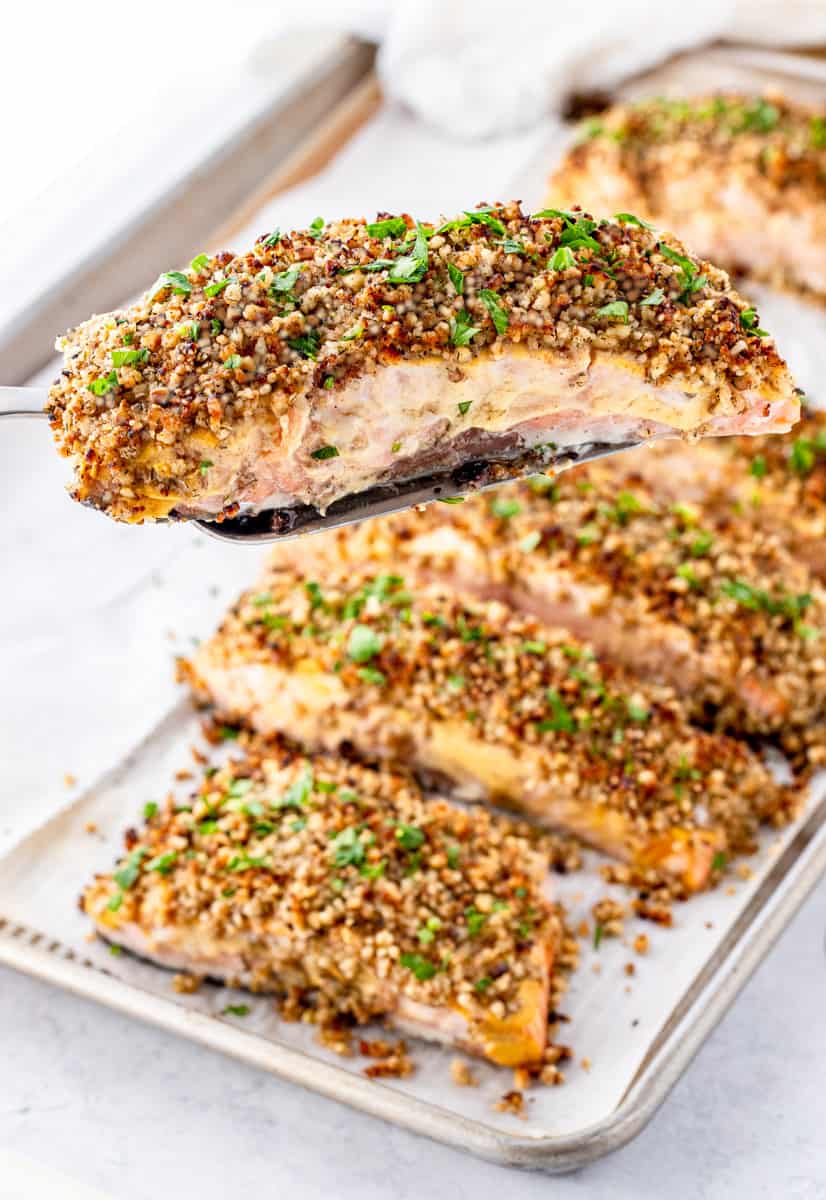
Storage and Reheating Guidelines
Refrigerator: Store in the fridge covered or in an airtight container for up to four days.
To reheat: When it comes to reheating this salmon recipe, it’s best to reheat it slowly, at a low temperature. Put the fish on a rimmed baking sheet and warm it in the oven set a 275°F oven for about 15 minutes, until it reaches an internal temperature of 125°F to 130°F. Go low and slow when reheating leftover salmon fillet to ensure that it won’t dry out.
You may also wish to squeeze some lemon juice over the surface of the fish to help preserve the original flavor and freshness of the fish.
Recipe FAQ
Generally, the cooking time will depend on the thickness of the fish fillet. Measure the thickness of your salmon once you have it on your pan. Bake salmon, uncovered, 4 to 6 minutes per 1/2-inch thickness. Always check your fish at the minimum baking time to ensure your baked salmon doesn’t get overcooked.
To test for doneness, insert a fork and gently twist. The salmon is done as soon as it becomes opaque and begins to flake. The fish juices should also be milky white. You can also tell if salmon is done by checking the temperature. The internal temperature should be 145°F when a meat thermometer is inserted into the thickest part of the fish.
Yes! This salmon reheats beautifully and still tastes great a couple of days after it’s cooked. If you wish, you can also just make the walnut crust mixture ahead of time to save on time when meal prepping.
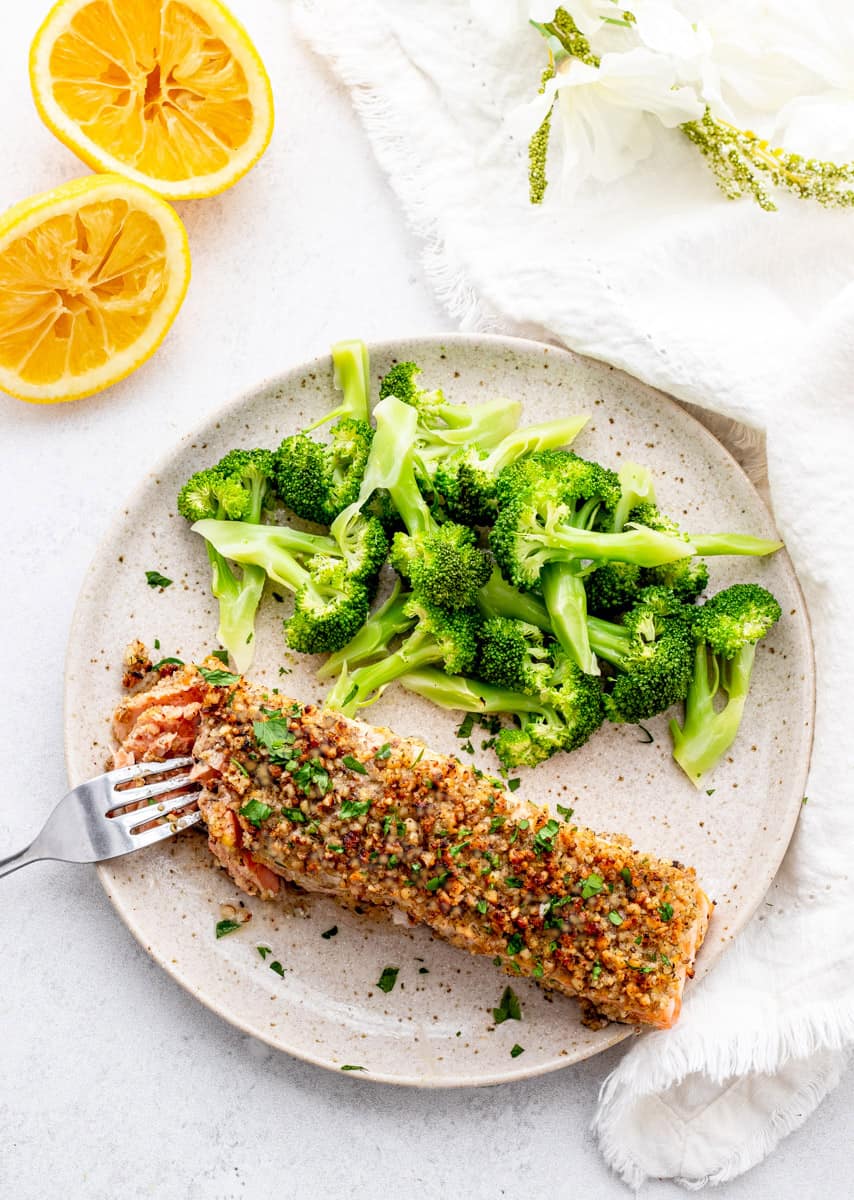
Serving Suggestions
This baked walnut-crusted salmon recipe is extremely versatile and pairs especially well with brown rice, or roasted potatoes and a side salad.
Try it out with any of the following sides:
- Waldorf Salad without Mayo
- Healthy Mashed Potatoes
- Roasted Brussels Sprouts and Sweet Potatoes
- Dill Potato Salad Recipe
- Wild Rice Pilaf with Cranberries and Apples
- Butternut Squash Barley Risotto
- Healthy Roasted Potatoes
- Healthy Mashed Sweet Potatoes
- Oven Roasted Broccoli
- Green Bean Almondine Recipe
- Spinach Orange Salad
- Maple Bacon Brussel Sprouts
Recipe Variations
- Try different fish: The walnut crust works well on other fatty fish too. Try it with arctic char or trout!
- Add some sweetness: Mix in a little maple syrup or honey with the Dijon mustard for a kick of extra sweetness.
- Make in air fryer: For an extra crunchy topping, try making this salmon in the air fryer. Cook it at 375 degrees for 10-12 minutes depending on the thickness of the salmon.
- Don’t have walnuts? If you don’t have walnuts on hand or want to keep this recipe nut-free, you can also use panko breadcrumbs for a delicious crunchy crust.
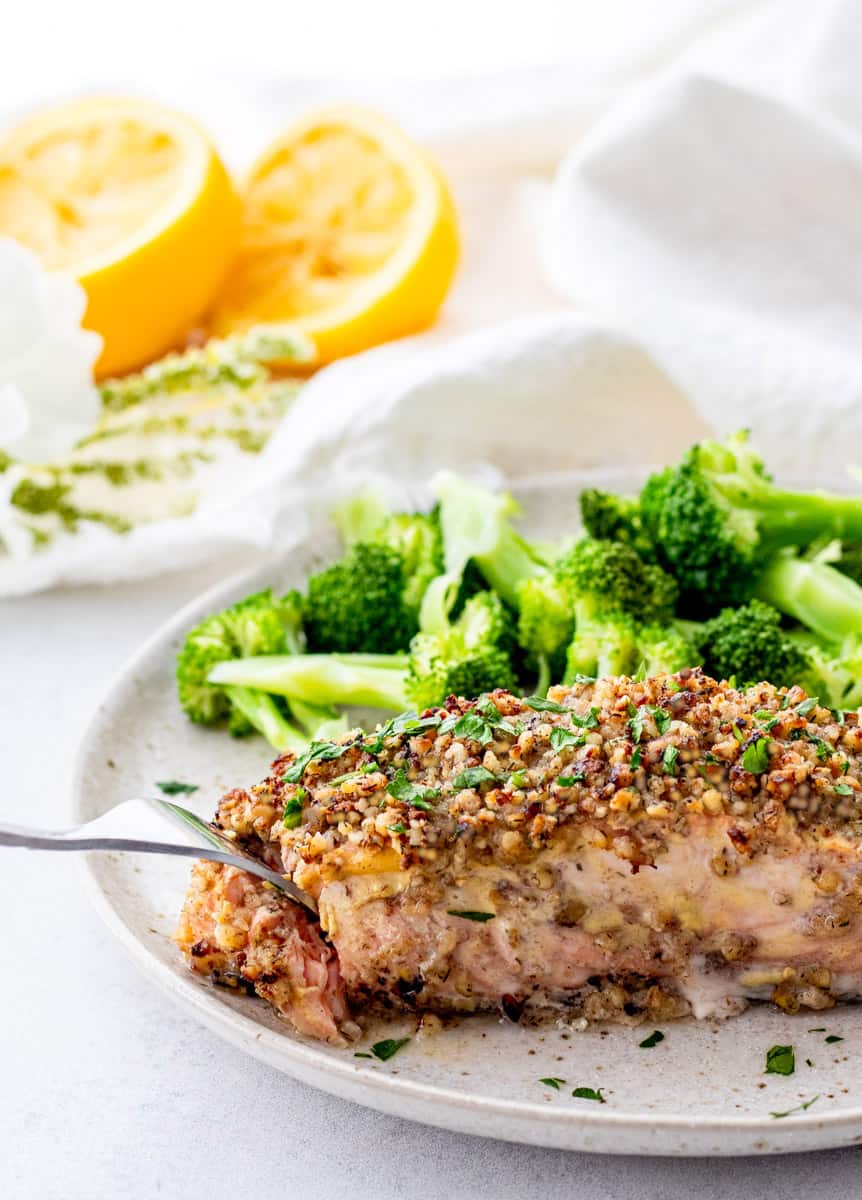
More Healthy Salmon Recipes
- Salmon Patties with Crackers
- Baked Pesto Salmon Recipe
- Dairy-Free Salmon Florentine
- Sun-dried Tomato Pesto Salmon
- Sweet Potato Salmon Cakes
Did you make this recipe? Scroll down to leave a star rating and review!
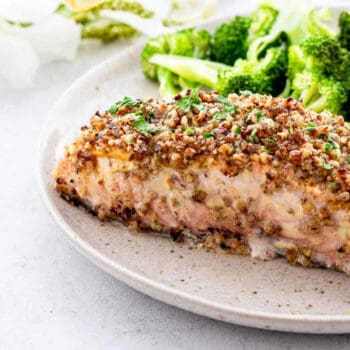
Walnut Crusted Salmon with Dijon Mustard
Ingredients
- 6 six oz salmon fillets
- 1 cup walnuts
- 1 tablespoon finely grated lemon rind
- 1 tablespoon olive oil
- 1 tablespoon fresh chopped dill or dried dill (or 1 tsp dried dill)
- 1/2 teaspoon garlic salt
- 1/4 teaspoon freshly ground pepper
- 4 tablespoons Dijon mustard
- 4 teaspoons lemon juice
To garnish
- Finely chopped parsley or chives
Instructions
- Preheat oven to 400°F. Line a baking sheet with parchment paper.
- Place walnuts in food processor; coarsely chop. Add lemon rind, olive oil, dill, garlic salt, and pepper; pulse until crumbly. Mixture should be crumbly and stick together slightly. Set aside.
- Arrange salmon fillets skin side down on the parchment paper lined baking sheets. Spread Dijon mustard evenly over the top and sides of the fillets.
- Evenly distribute walnut mixture over each fillet; gently pressing the mixture into the surface of the fish. You can also put some of the mixture on the sides if you have extra.
- Bake for 12-16 minutes, or until salmon flakes with a fork. You may need to increase the cooking time depending on the thickness of the fish fillet. You may also wish to broil for the last two minutes of cooking to get the edges brown and crispy. Just before serving, sprinkle each fillet with lemon juice.
Notes
- You can purchase salmon with or without the skin on. For fillets with skin, if desired, use a sharp fillet knife to remove the skin from the raw salmon. You can also remove the skin after baking. If any scales are on the skin, scrape them away before baking fish.
- If your salmon comes in one large piece, cut it into individual fillets before topping it with the Dijon and walnut mixture for easier baking and better presentation.
- I like to spread the Dijon mustard all over the fillets, including the tops and sides to infuse flavor into every bite.
- You may need to adjust the cooking time depending on the thickness of the fish fillet. The salmon should be pink and flake easily with a fork. See the FAQs below for a general guide on cooking times for salmon.
- To get the edges brown and crispy, you may wish to broil the fish for the last two minutes of cooking. Just be sure that you don’t place the baking sheet on the top shelf of the oven too close to the broiler or the walnuts may burn.
- Don’t overcook the salmon or it will be dry. Always check your fish at the minimum baking time to ensure your baked salmon doesn’t get overcooked.
Nutrition
This recipe was originally posted in June 2015 and was updated in October 2023 to include more helpful tips and photos.

















I usually have a lot of pecans on hand since I my grandparents always had pecan trees. From a health perspective, would pecans be a good substitute to walnuts?
Pecans would work great for this recipe! You’re still getting the healthy monounsaturated fats, vitamin E and fibre from the pecans, so they would be a good replacement for the walnuts.
Scrumptious yummy
So happy you enjoyed it Regina! Thanks so much for returning to leave a rating and review!
We loved this recipe! I used the exact ingredients listed, only I tripled the recipe and marinated for 24 and 48 hours. I thought the fish was even better after 48 hours. Also, 35 minutes was plenty for 3 fillets.
So glad you loved the recipe! I agree that the salmon tends to taste even better the next day! Thanks so much for stopping by to comment :)
What herbs are those green leaves on the top? Are those scallions?
Those are fresh chives that I used to garnish the salmon. Totally optional, it just adds a little additional colour and flavour :)
Salmon is my most favorite fish! This walnut crusted salmon is stunning, Elysia!
Thanks Julie! Salmon is totally my favourite fish too! The walnuts just take it to a whole new level~! Highly recommended :)